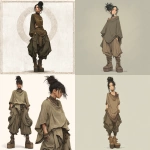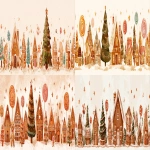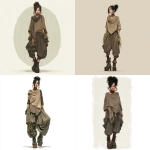Explore the Best AI Image Gallery

Blockchains Creative Revolution: Transforming Finance and Art
The world of finance and the creative industries are undergoing a profound transformation, driven by the emergence of blockchain technology. While blockchain is widely recognized for its role in cryptocurrencies and decentralized finance (DeFi), its potential extends far beyond these realms, particularly in revolutionizing how art is created, valued, and traded.
The Impact on Finance
Blockchains impact on the creative industry starts with finance. Traditional art markets are often plagued by intermediaries, opaque pricing models, and challenges in authenticating works. Blockchain offers a solution by creating transparent and immutable records of ownership and provenance. Smart contracts, self-executing agreements encoded on the blockchain, can automate royalty payments to artists, ensuring they receive fair compensation for their work every time it is resold.
NFTs: A New Era for Art Ownership
Non-fungible tokens (NFTs) have emerged as a game-changer in the art world. NFTs are unique digital assets that represent ownership of a specific piece of digital or physical artwork. They leverage blockchain technology to verify authenticity and ownership, providing artists with a new avenue for monetizing their work directly.
Potential Uses in the Creative Industry
Blockchains transformative potential extends beyond art transactions. Here are some exciting applications:
- Copyright Protection: Blockchain can be used to register and timestamp creative works, providing irrefutable proof of ownership and deterring copyright infringement.
- Digital Rights Management (DRM): Smart contracts on the blockchain can enforce licensing agreements for digital content, ensuring artists retain control over their works distribution and usage.
- Collaborative Creation: Blockchain allows multiple creators to contribute to a project and be fairly compensated for their contributions, fostering new forms of artistic collaboration.
Ethical Considerations
As with any powerful technology, blockchain in the creative industry raises ethical considerations:
- Accessibility and Inclusivity: Its crucial to ensure that blockchain-based tools are accessible to artists of all backgrounds and skill levels, preventing further marginalization.
- Environmental Impact: Some blockchain networks have high energy consumption. Exploring more sustainable solutions is essential for minimizing the environmental footprint of this technology.
- Data Privacy: While blockchain enhances transparency, its important to balance this with artists privacy rights and protect sensitive personal information.
Future Trends
The future of blockchain in the creative industry is bright. We can expect:
- Increased mainstream adoption: As awareness and understanding of blockchain grow, its integration into the creative sector will become more widespread.
- New decentralized platforms: Blockchain-based platforms will empower artists to connect directly with their audiences, bypassing traditional intermediaries.
- Hybrid models: Well see a convergence of blockchain technology with other emerging trends, such as artificial intelligence (AI) and augmented reality (AR), leading to innovative new forms of creative expression.
Blockchain technology is poised to reshape the creative industry, empowering artists, fostering transparency, and unlocking new possibilities for artistic innovation. By embracing this transformative technology responsibly and ethically, we can usher in a new era of creativity and collaboration.




](https://images.ai-img.art/thumbnails/150/42d2d357bc68a8f707abfc29c35e7c9b5388d6559e4e2b94ba648cf0cf734bb1.webp)






](https://images.ai-img.art/thumbnails/150/21e921e68d4754d45ff17adc76eeaabe152c41a580321a7ec899dcfdf935afca.webp)


























](https://images.ai-img.art/thumbnails/150/a386b7328d9a450c8a0cafbdad5815eeb35b0177d0e8fa85f97cbaa5fee75954.webp)





](https://images.ai-img.art/thumbnails/150/ec0cb0bee85af7229e33a02acb89441c1cf702d21b383b244148fbc0d36b85dc.webp)




